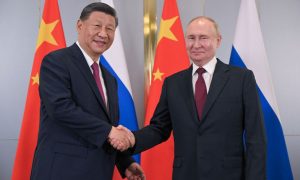The Indian Ocean has been getting considerable focus quite recently, with a joint session of naval chiefs of littoral states sitting in Bangkok for the Indian Ocean Naval Symposium banner. Regional states have been seeking maritime cooperation among the regional navies of the Indian Ocean through this symposium in 2008.
Earlier, China also held a maritime conference in Kunming to enhance blue-economy cooperation with select Indian Ocean nations under the theme of “Boosting Sustainable Blue Economy to Build Together a Maritime Community with a Shared Future.” In this conference, the Indian Ocean region was referred to as the “China-Indian Ocean Region.” India was not among the invited nations. This is indicative of the great game which has already started in the Indian Ocean region.
The Indian Ocean Region has emerged as a theater of competition between the competing powers which are pursuing strategies to maximize their relative share of power. This region has gained tremendous political, economic, and strategic importance. Robert D Kaplan in his famous book “Monsoon” states that the Indian Ocean region has historically been a critical hub of trade and cultural exchange. As Kaplan highlights, the region’s significance has only increased in recent years as globalization and trade liberalization have accelerated. With countries around the world seeking to secure resources, markets, and strategic advantages, the Indian Ocean has emerged as a key arena for economic, political, and military competition.
China’s growing presence in the Indian Ocean serves as a prime example of the region’s increasing significance. The Chinese government’s Belt and Road Initiative is an ambitious project that aims to enhance connectivity with countries worldwide, particularly those bordering the Indian Ocean. Due to huge investments in infrastructure projects like railways, ports, and economic zones, China has shaped new lucrative realities and transferred geopolitical dimensions in the regional states.”
However, the Indian Ocean region is also a playground for the US, Russia, and other states. Indian Ocean is crucial for the US to maintaining open sea lanes, protecting its military interests, and countering the rise of China. The United States operates military bases in Diego Garcia and supports navies across the region to ensure its presence and ability to project power. The US has embarked upon the Asia-Pacific rebalancing strategy in its pursuit to encircle China with the help of regional states. This leads to a realignment of strategic relations in the Indian Ocean region, whereby few states have emerged as major US Defence Partner yet caught between follies and mistrust in relations with the USA and Canada.
Russia, instead, finds the Indian Ocean as a prospect to enlarge its sway and confront Western supremacy.
With the advent of the twenty-first century, the Indian Ocean Region has been witnessing unprecedented political transformation that involves changing strategic engagements, economic cooperation, military build-ups, and evolving force postures. The key changing trends present challenges as well as opportunities for regional and extra-regional states to register their hegemony and securing vital interests in the region.
The emerging strategic partnerships and naval force postures that also include the development of sea-based nuclear capabilities suggest the heightening competition and potential arms race among the regional states, thus reducing the probability of mutual cooperation.
The major powers competing in the Indian Ocean recognize that supremacy in this region would play a key role in realizing their political aspirations at the global level and in structuring the multipolar strategic future. Mackinder’s Heartland Theory argues that the multilateral engagements in the Indian Ocean would have a considerable impact on global geopolitics.
One of the significant opportunities presented by the monsoon is the potential for renewable energy generation. The powerful monsoon winds offer countries like India an excellent opportunity to harness wind energy. By tapping into this natural resource, these nations can reduce their reliance on fossil fuels, enhance energy security, promote sustainable development, and contribute to the global fight against climate change. The monsoon winds can power wind turbines, generating electricity that can be used for various purposes, from powering households to fueling industries. This can have a changing effect on the energy model of the region and produce new chances for the masses of the regional nations.
In the context of the Indian Ocean, Iran and Sri Lanka occupy strategic importance in geopolitics.
The geostrategic location of Sri Lanka makes it important for all players desirous to have access to Indian Ocean trade routes. Chahbahar Port has significant importance in relation to connectivity between South Asia and Central Asian states.
China’s presence in the region has created unrest for the US, UK, and France, who were having influence on six islands in the region. The new relationship are more like a contest model. Russia has also established a new naval base in Sudan, which provides Moscow with strategic access to the Red Sea and, by extension, to Bab-el-Mandeb, one of the key choke points in the Indian Ocean.
A few states like India are attempting to become key partners for smaller nations such as Sri Lanka and the Maldives and, to an extent, Mauritius and Seychelles. On the other hand, France is the key partner for French-speaking Madagascar and Comoros. However, China stands to compete with the UK and France simultaneously across the six islands in the region. Of all the major powers in the Indian Ocean, China is the single one with a diplomatic mission present across almost all six islands.
Post 9/11, a new framework of geopolitics includes both the Indian and Pacific Oceans, which has pushed the Indian Ocean back into the spotlight after a period with no serious great power competition in the region. Indian ocean is vital trading hub and importance of sub regions included in the Indian ocean makes it important in terms of military and strategic engagements. Any disruption along its trading routes will impact the entire globe’s energy security, let alone that of significant economies like China, Japan, and South Korea, which depend on energy imported primarily via the Malacca strait.
Indian Navy claims the entire Indian Ocean as its area of responsibility and prides itself on being the first to respond to natural and humanitarian disasters there. Sri Lanka is an analytically pertinent geostrategic zone within the Indian Ocean and is well-placed in terms of naval presence which has the potential to influence seaborne trade and the maritime presence of other countries.
Sri Lanka being neighbor of open sea has major implication on new framework of geopolitics in Indian ocean. the Southeast Asian choke points of the Malacca, Sunda and Lombok Straits affect the economic vitality of the Asia-Pacific region. Measured by the sheer volume of merchant traffic transiting these straits, in 1993, almost half of the world’s merchant fleet capacity and one-third of the world’s ships sailed through these choke points.1 Shipping traffic through the Malacca Strait is several times greater than the traffic either through the Suez Canal or the Panama Canal. The shipping lane transiting the Indian Ocean and entering the strategic choke point of Southeast Asia has great geostrategic importance to the United States, China, Japan, Korea, Taiwan and the Southeast Asian countries. Given these conditions, the northern Indian Ocean is booming with maritime activity, and both economic and security interests impact in a concentrated form.
By its very location, India in the Indian ocean lies approximately half way between the Strait of Hormuz and the Strait of Malacca. Both these choke points have the potential to become major flash points. There are alternatives to the Strait of Malacca but there are no other routes to transport the Arabian Gulf oil except through pipelines over land, which have their own vulnerabilities. Therefore, any contingency in the Strait of Hormuz has direct implications for the region.
By its geographic location, the Indian peninsula dominates the SLOCs from the Arabian Gulf before they round off south of Dundra Head in Sri Lanka. Further, this SLOC passes close to the Indian islands of Andaman and Nicobar before entering the Malacca Strait. The mercantile traffic transiting the Malacca Strait passes close to the Indian area of maritime interest and, therefore, any unforeseen contingency or development in the Malacca Strait places greater responsibility on regional states to preserve order at sea.
Iran is strategically the most important state in the Arabian Gulf. It controls the straits of Hurmuz, and it possesses one of the largest gas reserves in the world. Thus, Indian Ocean regions are the focus of global attention for trade and energy routes.























